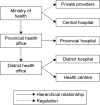Misoprostol for the prevention of postpartum hemorrhage during home births in rural Lao PDR: establishing a pilot program for community distribution
- PMID: 29785142
- PMCID: PMC5953317
- DOI: 10.2147/IJWH.S150695
Misoprostol for the prevention of postpartum hemorrhage during home births in rural Lao PDR: establishing a pilot program for community distribution
Abstract
Purpose: The purpose of this study was to gather the necessary data to support the design and implementation of a pilot program for women who are unable to deliver in a healthcare facility in the Lao People's Democratic Republic (PDR), by using community distribution of misoprostol to prevent postpartum hemorrhage (PPH). The study builds on an earlier research that demonstrated both support and need for community-based distribution of misoprostol in Lao PDR.
Methods: This qualitative study identified acceptability of misoprostol and healthcare system needs at varying levels to effectively distribute misoprostol to women with limited access to facility-based birthing. Interviews (n=25) were undertaken with stakeholders at the central, provincial, and district levels and with community members in five rural communities in Oudomxay, a province with high rates of maternal mortality. Focus group discussions (n=5) were undertaken in each community.
Results: Respondents agreed that PPH was the major cause of preventable maternal mortality with community distribution of misoprostol an acceptable and feasible interim preventative solution. Strong leadership, training, and community mobilization were identified as critical success factors. While several participants preferred midwives to distribute misoprostol, given the limited availability of midwives, there was a general agreement that village health workers or other lower level workers could safely administer misoprostol. Many key stakeholders, including women themselves, considered that these community-level staff may be able to provide misoprostol to women for self-administration, as long as appropriate education on its use was included. The collected data also helped identify appropriate educational messages and key indicators for monitoring and evaluation for a pilot program.
Conclusion: The findings strengthen the case for a pilot program of community distribution of misoprostol to prevent PPH in remote communities where women have limited access to a health facility and highlight the key areas of consideration in developing such a program.
Keywords: Lao PDR; community distribution; misoprostol; postpartum hemorrhage; prevention.
Conflict of interest statement
Disclosure The authors report no conflicts of interest in this work.
Figures
References
-
- WHO . Essential Obstetric Care: Fact Sheet No. 245. Geneva, Switzerland: WHO Press; 2015.
-
- Prata N, Gessessew A, Abraha AK, Holston M, Potts M. Prevention of postpartum hemorrhage: options for home births in rural Ethiopia. Afr J Reprod Health. 2009;13(2):87–95. - PubMed
-
- Rajan PV, Wing DA. Postpartum hemorrhage: evidence-based medical interventions for prevention and treatment. Clin Obstet Gynecol. 2010;53(1):165–181. - PubMed
-
- Say L, Chou D, Gemmill A, et al. Global causes of maternal death: a WHO systematic analysis. Lancet Glob Health. 2014;2(6):e323–e333. - PubMed
LinkOut - more resources
Full Text Sources
Other Literature Sources


